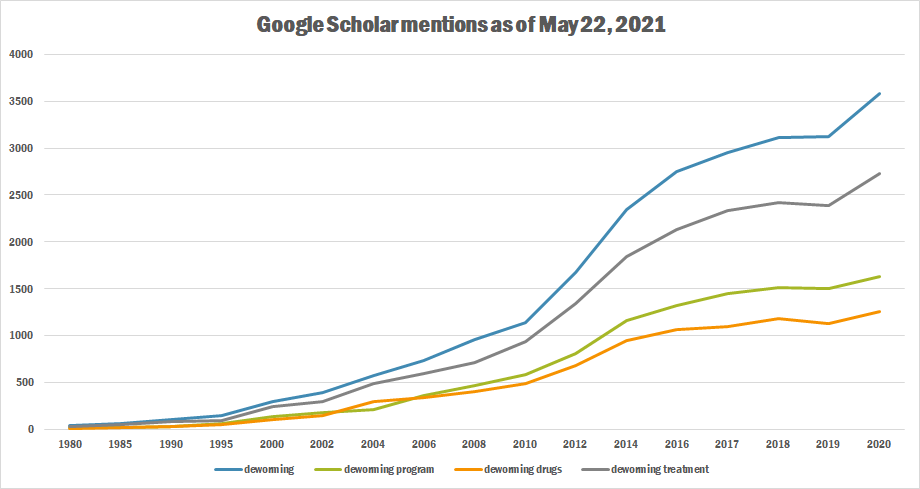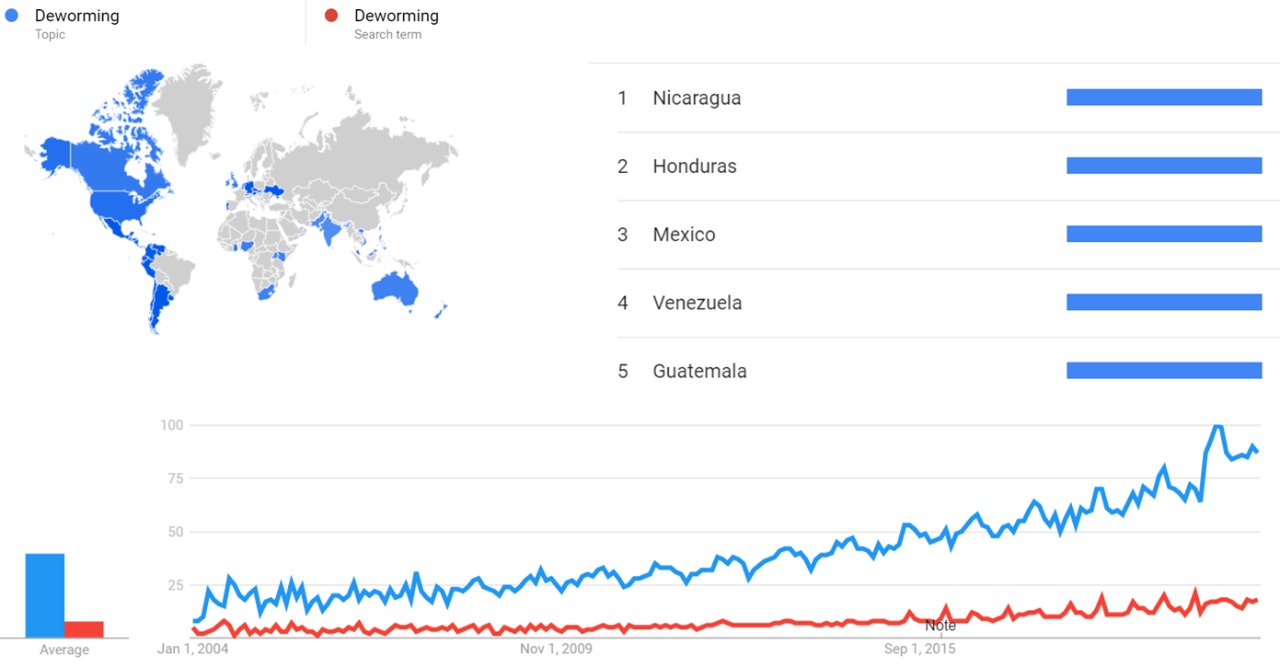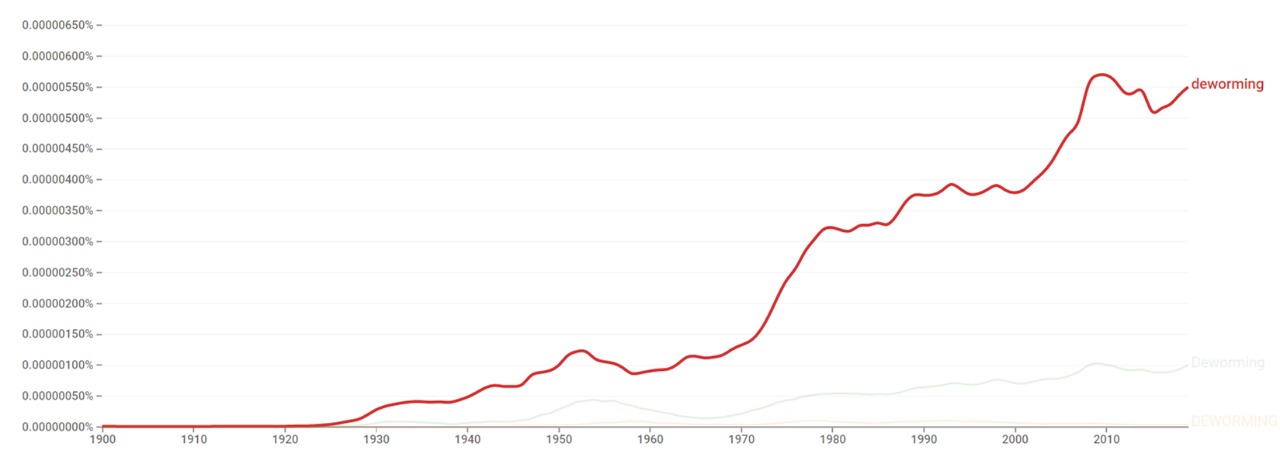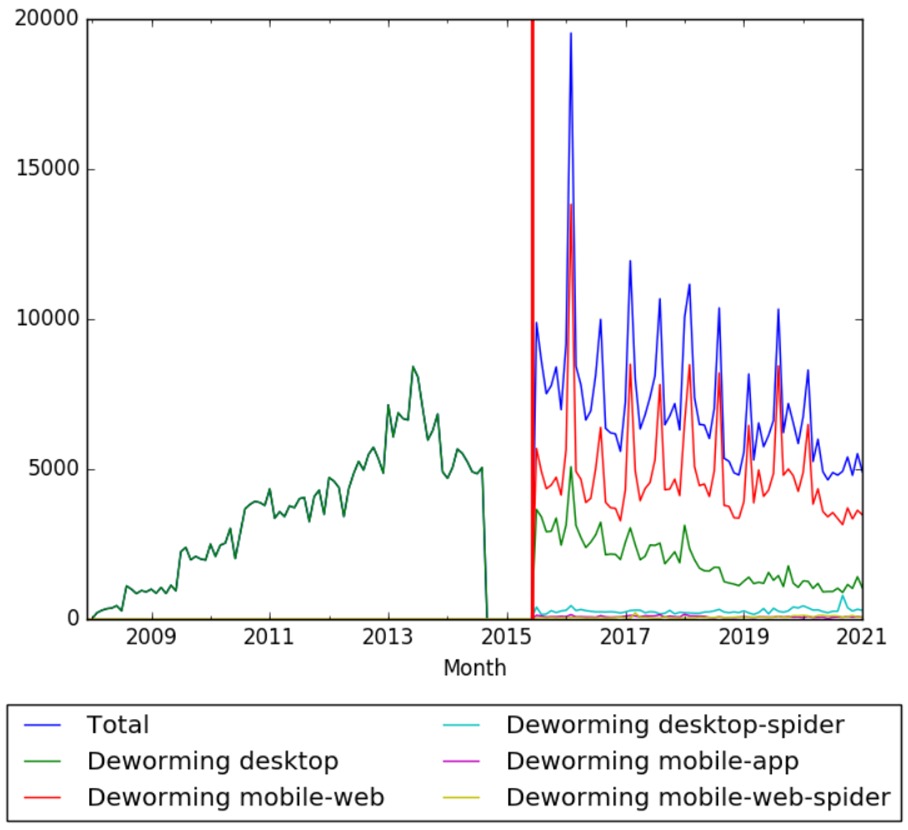Timeline of deworming
Jump to navigation
Jump to search
The content on this page is forked from the English Wikipedia page entitled "Timeline of deworming". The original page still exists at Timeline of deworming. The original content was released under the Creative Commons Attribution/Share-Alike License (CC-BY-SA), so this page inherits this license.
This is a timeline of deworming, and specifically mass deworming.
Big picture
| Time period | Key developments |
|---|---|
| Late 17th century | Birth of modern helminthology as European physicians first detail anatomy of parasitic worms. |
| 1851–1915 | Understanding of and interest in schistosomiasis deepens as more people come in contact with the disease. |
| 1948–present | Following World War II, the World Health Organization "has been the principal body concerned with the international support of research and control programmes" of schistosomiasis.[1]: 266 However, despite this and the implementation of programs, prevalence of schistosomiasis increases in many areas.[1]: 262 |
| 1949–1997 | Both Japan and South Korea successfully implement national programs to essentially eliminate soil-transmitted helminthiasis. |
| 2001–present | The World Health Assembly declares deworming as a focus. Various deworming organizations form. |
Full timeline
| Year | Event type | Event | Disease name | Geographic location |
|---|---|---|---|---|
| 16th century BC | Schistosome parasites thought to first evolve in the Great Lakes of East Africa around this period.[1] | Schistosomiasis | Africa | |
| 16th century BC | Guinea Worm is described in several ancient Egyptian texts, and is thought to be common in the area[2] | Dracunculiasis | Egypt | |
| 1st Century – 7th Century | Discovery | Roman and Byzantine physicians are familiar with human roundworms and tapeworms and the infections that they cause.[3] | Roundworm, tapeworm | Roman Empire |
| 1683-1684 | Discovery | Birth of modern helminthology. Detailed anatomy of the roundworm (Ascaris lumbricoides) is described, first by English physician Edward Tyson (1683), and shortly afterward by the Italian Francesco Redi (1684).[3] | Roundworm | England, Italy |
| 1799–1801 | Crisis | Napoleon's soldiers almost certainly suffer from haematuria caused by schistosomiasis infection.[1] | Schistosomiasis | |
| 1851 | Discovery | Theodor Bilharz discovers the parasite responsible for schistosomiasis.[1] | Schistosomiasis | |
| 1882 | Publication | First mention of schistosomiasis in The Lancet.[1] | Schistosomiasis | |
| 1883 | Interest in schistosomiasis heightens in England (and Europe more generally) due to more frequent encounter with the disease following English occupation of Egypt.[1] | Schistosomiasis | England, Egypt | |
| 1893–1918 | Program launch | Four commissions designed to understand schistosomiasis are sent to North Africa.[1] | Schistosomiasis | Africa |
| 1898 | Discovery | Scientist Arthur Looss discovers that hookworms enter the body by boring through the skin when he accidentally infects himself.[3] | Hookworm | |
| 1909 | Organization | The Rockefeller Sanitary Commission for the Eradication of Hookworm Disease (RSC) is founded. One of RSC's main goals is to eradicate hookworm disease in Southern United States.[4][5] The RSC is active from 1910–1914, and closes in 1915.[6] It is replaced by the International Health Division (IHD), another Rockefeller Foundation initiative, which tackled public health concerns on a global level.[7] | Hookworm | United States |
| 1914–1934 | Overdose of oil of chenopodium, administered as part of the Rockefeller hookworm eradication program, causes over 200 documented deaths. More than 80% of deaths occur in children under 12.[8] | Hookworm | ||
| 1915 | Discovery | Robert Thomson Leiper works out the life-cycle of schistosomiasis.[1] | Schistosomiasis | |
| 1926–1931 | Successful eradication | Guinea Worm is eradicated in Uzbekistan through a series of health education and sanitation measures.[2] | Dracunculiasis | Uzbekistan |
| 1927–1951 | Attempts are made to kill the intermediate hosts for schistosomiasis (i.e. snails) using copper sulfate instead of sanitation and health education. The reasoning here is to prevent the schistosomiasis life-cycle from being completed. However it is unclear if these measures reduced the prevalence of schistosomiasis.[1] | Schistosomiasis | ||
| 1938 | Schistosomiasis Commission proposed by Hilmy Bey; the League of Nations Health Committee suggests more research on the disease, but nothing is done due to the imminence of World War II (among other reasons).[1] | Schistosomiasis | ||
| 1939–1945 | Crisis | Allied soldiers affected by schistosomiasis in China, the Philippines, and the Pacific Islands. This brings the disease to international attention.[1] | Schistosomiasis | |
| 1942 | Program launch | Schistosomiasis control program begins in Venezuela.[1] | Schistosomiasis | Venezuela |
| 1947 | Publication | First assessment of the distribution of schistosomiasis in the world by Norman Stoll.[1] | Schistosomiasis | |
| 1948 | Program launch | The first World Health Assembly decides to establish an "Expert Committee" to deal with schistosomiasis.[1] | Schistosomiasis | |
| 1949 | Program launch | Volunteer organizations for deworming form in Tokyo and Osaka, which implement "biannual school-based mass screening and treatment".[6] | Soil-transmitted helminthiasis | Japan |
| 1955 | Program launch | Japan Association of Parasite Control (JAPC) forms. JAPC is a consolidation of several previous deworming groups that existed.[6] | Soil-transmitted helminthiasis | Japan |
| 1965–1995 | Program launch | Korea Association for Parasite Eradication models their deworming program (a "biannual school-based mass screening and treatment program") off Japanese programs.[6] | Soil-transmitted helminthiasis, hookworm, etc. | South Korea |
| 1971 | Successful eradication | Iran eliminates dracunculiasis.[2] | Dracunculiasis | Iran |
| mid-1980s | Under Japan Association of Parasite Control, deworming efforts lead to "very minimal levels" of Ascaris.[6] | Soil-transmitted helminthiasis | Japan | |
| 1986–present | Organization | The Carter Foundation begins a campaign to eradicate Guinea worm. The incidence of guinea worm infection declines sharply, from an estimated 3.5 million cases in 1986 to 22 reported cases in 2015.[9] | Dracunculiasis | |
| 1997 | The World Health Organization declares South Korea "essentially worm-free".[6] | Soil-transmitted helminthiasis | South Korea | |
| 2001 | The World Health Assembly declares the goal of 75% of schoolchildren in endemic areas receiving deworming treatment.[5]: 2 | Schistosomiasis, Soil-transmitted helminthiasis[10] | ||
| 2002 | Organization | The Schistosomiasis Control Initiative (SCI) established after being funded by the Bill & Melinda Gates Foundation.[11] Since 2013 SCI has been a GiveWell top charity. | Schistosomiasis | |
| 2007 | Organization | Deworm the World Initiative is founded.[12] Since 2014 Deworm the World Initiative has been a GiveWell top charity. | Soil-transmitted helminthiasis | |
| 2012 | Program launch | Various organizations announce a coordinated effort to eliminate or control 10 neglected tropical diseases, including both schistosomiasis and soil-transmitted helminthiasis.[13] | Schistosomiasis, soil-transmitted helminthiasis | |
| 2015 | The "deworming debate" takes place starting in July on whether deworming is effective.[14] |
Numerical and visual data
Google Scholar
The following table summarizes per-year mentions on Google Scholar as of May 22, 2021.
| Year | deworming | deworming program | deworming drugs | deworming treatment |
|---|---|---|---|---|
| 1980 | 42 | 15 | 11 | 32 |
| 1985 | 66 | 24 | 21 | 54 |
| 1990 | 103 | 33 | 34 | 84 |
| 1995 | 145 | 62 | 50 | 99 |
| 2000 | 300 | 140 | 105 | 247 |
| 2002 | 391 | 176 | 150 | 295 |
| 2004 | 577 | 207 | 295 | 493 |
| 2006 | 735 | 360 | 342 | 595 |
| 2008 | 954 | 471 | 400 | 710 |
| 2010 | 1,140 | 583 | 490 | 932 |
| 2012 | 1,670 | 810 | 686 | 1,340 |
| 2014 | 2,340 | 1,160 | 946 | 1,840 |
| 2016 | 2,750 | 1,320 | 1,060 | 2,130 |
| 2017 | 2,950 | 1,450 | 1,100 | 2,330 |
| 2018 | 3,110 | 1,510 | 1,180 | 2,420 |
| 2019 | 3,120 | 1,500 | 1,130 | 2,390 |
| 2020 | 3,580 | 1,630 | 1,260 | 2,730 |

Google Trends
The comparative chart below shows Google Trends data for Deworming (Topic) and Deworming (Search Term), from January 2004 to February 2021, when the screenshot was taken. Interest in the topic is also ranked by country and displayed on world map.[15]

Google Ngram Viewer
The chart below shows Google Ngram Viewer data for Deworming, from 1900 to 2019.[16]

Wikipedia Views
The chart below shows pageviews of the English Wikipedia article Deworming, on desktop from December 2007, and on mobile-web, desktop-spider, mobile-web-spider and mobile app, from July 2015; to January 2021.[17]

See also
- Timeline of global health
- List of diseases eliminated from the United States
- Helminthiasis
- Soil-transmitted helminthiasis
- Schistosomiasis
- Timeline of cholera
References
- ↑ 1.00 1.01 1.02 1.03 1.04 1.05 1.06 1.07 1.08 1.09 1.10 1.11 1.12 1.13 1.14 Sandbach, F. R. (July 1976). "The History of Schistosomiasis Research and Policy for Its Control" (PDF). Med Hist. 20 (3): 259–75. doi:10.1017/s0025727300022663. PMC 1081781. PMID 792584. Retrieved April 16, 2016.
- ↑ 2.0 2.1 2.2 "Dracunculiasis: Historical background". World Health Organization. Retrieved June 26, 2016.
- ↑ 3.0 3.1 3.2 Cox, F. E. G. (2002-10-01). "History of Human Parasitology". Clinical Microbiology Reviews. 15 (4): 595–612. doi:10.1128/CMR.15.4.595-612.2002. ISSN 0893-8512. PMC 126866. PMID 12364371.
- ↑ "Rockefeller Sanitary Commission (RSC)". The Rockefeller Foundation. Retrieved April 22, 2016.
- ↑ 5.0 5.1 "Worms, wisdom, and wealth: why deworming can make economic sense" (PDF). 2013. Retrieved April 16, 2016.
{{cite web}}: Unknown parameter|authors=ignored (help) - ↑ 6.0 6.1 6.2 6.3 6.4 6.5 "STH Elimination Strategy Support - Objective 1: Past STH Elimination Programs" (PDF). University of Washington Global Health START Program. February 17, 2015.
- ↑ Center, Rockefeller Archive. "100 Years: The Rockefeller Foundation | International Health Division · Health". rockefeller100.org. Retrieved 2016-06-26.
- ↑ PALMER, STEVEN (2010-04-01). "Toward Responsibility in International Health: Death following Treatment in Rockefeller Hookworm Campaigns, 1914–1934". Medical History. 54 (2): 149–170. doi:10.1017/s0025727300000223. ISSN 0025-7273. PMC 2844286. PMID 20357984.
- ↑ "Guinea Worm Eradication Program". www.cartercenter.org. Retrieved 2016-06-26.
- ↑ "WHA54.19 Schistosomiasis and soil-transmitted helminth infections" (PDF). World Health Organization.
- ↑ "About". Schistosomiasis Control Initiative. Retrieved April 23, 2016.
- ↑ "Deworm the World Initiative, led by Evidence Action". GiveWell. April 2016.
- ↑ "Table of Commitments" (PDF). Uniting to Combat Neglected Tropical Diseases. 2012. Archived from the original (PDF) on March 12, 2013. Retrieved April 23, 2016.
{{cite web}}: Unknown parameter|deadurl=ignored (|url-status=suggested) (help) - ↑ "Timeline: the deworming debate". The Cochrane Collaboration. Retrieved April 23, 2016.
- ↑ "Deworming". Google Trends. Retrieved 15 February 2021.
- ↑ "Deworming". books.google.com. Retrieved 16 February 2021.
- ↑ "Deworming". wikipediaviews.org. Retrieved 21 February 2021.